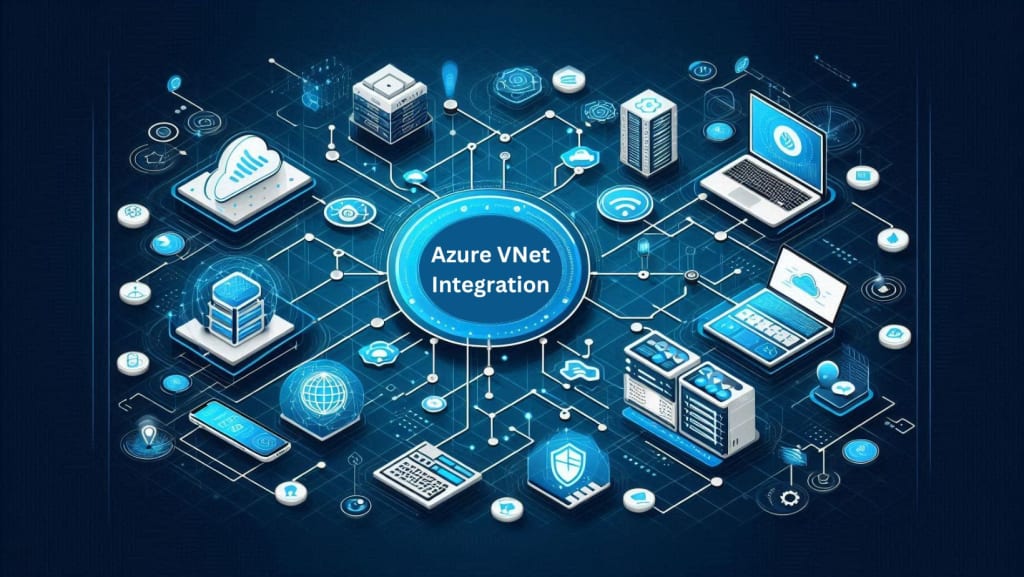Azure VNet Integration: Seamless Connectivity for Your Cloud Resources
Discover the benefits of Azure VNet integration, its various types, and the steps required for implementation.

Azure offers various services and features to help companies streamline their operations, enhance scalability, and improve overall efficiency. Among these features, Azure VNet Integration is crucial in enabling secure and seamless connectivity between your on-premises and cloud-based resources.
Understand Azure Virtual Networks (VNets)
Before diving into Azure VNet Integration, it's essential to understand Azure Virtual Networks (VNets) and their importance in the cloud computing ecosystem. A VNet is a logically isolated section of the Azure cloud focused on your enterprise. It serves as a secure, private space where you can deploy and manage your Azure resources, such as virtual machines (VMs), web applications, databases, and more.
VNets Benefits
Isolation: VNets isolate your resources from other Azure tenants, ensuring enhanced security and privacy.
IP Address Management: You can define your own IP address space within a VNet, allowing for better organization and control of your resources.
Subnet Segmentation: VNets support the creation of subnets, enabling you to segment your resources based on specific requirements or security zones.
Network Security: Azure VNets have built-in network security tools for controlling incoming and outgoing traffic.
The Need for VNet Integration
While VNets offers a robust and secure environment for your cloud-based resources, many businesses still maintain on-premises infrastructure or have resources hosted in other cloud environments. In such scenarios, VNet Integration becomes crucial for enabling seamless communication and connectivity between these disparate environments.
Types of Azure VNet Integration
Azure offers two primary methods for VNet Integration: Site-to-Site VPN and Azure ExpressRoute.
- Site-to-Site VPN: It is a cost-effective and easy-to-configure option for establishing a secure connection between your local network and Azure VNet. It benefits companies with a smaller on-premises footprint or those looking for a quick and efficient way to extend their network to Azure.
- Azure ExpressRoute: For businesses with more demanding connectivity requirements or those seeking a higher level of reliability and performance, Azure ExpressRoute is the recommended solution. It provides a dedicated, private link between your local network and Azure VNet, bypassing the public internet entirely.
Benefits of VNet Integration
Integrating your on-premises network with your Azure VNet offers numerous benefits for your organization, including:
Hybrid Cloud Enablement
Azure VNet Integration allows you to leverage the scalability and cost-effectiveness of the cloud while maintaining your existing on-premises infrastructure, enabling a true hybrid cloud environment.
Seamless Connectivity
With VNet Integration, your on-premises resources can communicate with your cloud-based resources as if they were part of the same network, eliminating the need for complex network configurations and enabling seamless data flow.
Enhanced Security
By extending your on-premises network to Azure, you can leverage the robust security features and controls provided by Azure, ensuring consistent security policies and practices across your entire infrastructure.
Increased Flexibility
Azure VNet Integration provides the flexibility to leverage both on-premises and cloud-based resources, allowing you to take advantage of each environment's strengths and optimize your workloads accordingly.
Simplified Management
With a unified infrastructure spanning on-premises and cloud environments, you can streamline management and maintenance processes, reducing complexity and improving operational efficiency.
Azure VNet Integration Implementation
Implementing VNet Integration requires careful planning and consideration of your company's specific requirements and existing infrastructure. Here are some general steps to get started:
- Assess Your Current Infrastructure: Evaluate your existing on-premises network, resources, and connectivity requirements to determine the appropriate VNet Integration solution (Site-to-Site VPN or ExpressRoute).
- Plan Your VNet Architecture: Design your Azure VNet architecture, including IP address spaces, subnets, and any necessary network segmentation or security requirements.
- Configure On-premises Connectivity: Depending on your chosen integration method, set up the necessary on-premises infrastructure and connectivity components, such as VPN gateways or ExpressRoute circuit provisioning.
- Deploy and Configure Azure Resources: Deploy your Azure resources within the VNet, including virtual machines, web applications, databases, and any other required services.
- Test and Validate Connectivity: Thoroughly test and validate the connectivity between your on-premises resources and your Azure VNet to ensure proper functionality and performance.
- Implement Security Measures: To protect your hybrid infrastructure, configure appropriate security measures, such as network security groups (NSGs), route tables, and firewall rules.
- Monitor and Manage: Continuously monitor and manage your hybrid infrastructure, including both on-premises and cloud-based resources, to maintain optimal performance, security, and compliance.
Conclusion
Azure VNet Integration is a powerful feature that allows companies to seamlessly extend their on-premises network to the Azure cloud, creating a true hybrid cloud infrastructure. By integrating your on-premises resources with your Azure VNet, you can take advantage of the scalability, cost-effectiveness, and advanced features of the cloud while preserving your existing investments and infrastructure. Leveraging Microsoft Azure Integration Services for VNet Integration can help your business reach new heights.
About the Creator
Dhruvil Joshi
I'm a dynamic digital marketing executive with experience in the IT industry, I've developed a deep understanding of the unique challenges and opportunities that come with technologies.
Enjoyed the story? Support the Creator.
Subscribe for free to receive all their stories in your feed. You could also pledge your support or give them a one-off tip, letting them know you appreciate their work.





Comments (3)
Great content! Keep up the good work.
Excellent post! Your guidance on implementing Azure VNet Integration is very practical.
This is a fantastic overview of Azure VNet Integration! Great work!